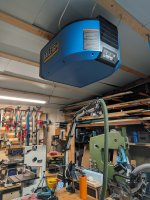I've enjoyed cigars for many years and part of that has been constantly working on and designing room air filtration/extraction, so when I got into woodworking, there was some symbiosis. For cigars, the best is to just extract and replace with fresh conditioned air. However, that gets to be quite a proposition, but it's still my preference. And I want rapid extraction because I don't want the cigar smoke lingering.
For my woodworking space (the garage), I've been building a Corsi-Rosenthal type unit that will utilize a 20 inch box fan and five 20"x20"x1" Merv 14 filters. The multiple filters give the same kind of surface area that you'll find in a canister type filter, and anything above Merv13 gives HEPA-like filtration. My filters just arrived yesterday so I'll be pushing the box build up next.
I looked at the units mentioned in this thread, like the JET, Powermatic, Wen and some others. My friend has the Delta version in his shop, and they work well enough - but my concern is that they don't move enough air quickly enough. So, for similar money, you can build a Corsi-Rosenthal type box and gain better performance. Plus, I don't think the filtration performance with the commercial units are really that fine.
Of course, any of these filters work better if you can locate the filter next to the working tool. I've been testing this out with another 20" box fan that I've bungeed a 16x20x4 Merv 12 filter (it was at The ReStore for $20) to it and have been placing it near the workpieces and the results are positive. Unfortunately, I'm running tight on space so having a large air filter on wheels to roll around is not in the plan - I'm going to fly it above. Perhaps not the most optimal but I'm betting on the greater CFM giving a little advantage.
Someone else mentioned that air filtration and tool extraction have to go hand-in-hand and I agree. It could be just tool extraction but if you're not using that and only air filtration, the dust is still going everywhere - and in a recent Fine Woodworking podcast, Seri Robinson noted that airborne dust particles can remain airborne in your workshop for up to 72 hours. In addition to my CT MIDI I, I've also upgraded my Rigid 14ga shop vac with both the Dustopper and HEPA bag and filter - those upgrades have been worth the cost and effort.

